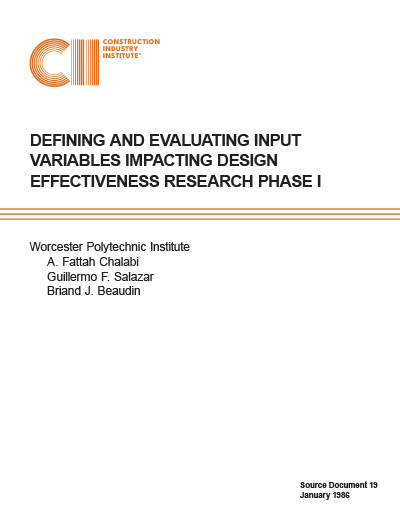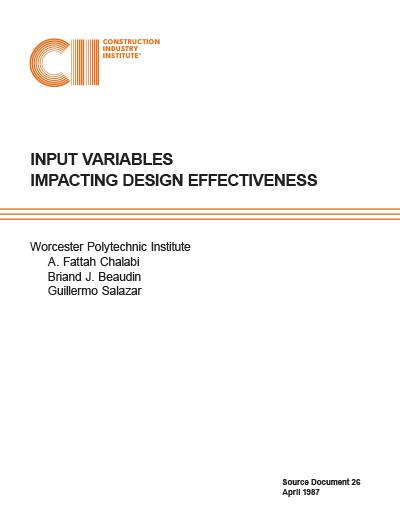
Defining and Evaluating Input Variables Impacting Design Effectiveness: Research Phase I
Industrial project completion is traditionally considered to consist of four distinct steps of planning: design, construction, operation, and maintenance. Each of these steps has been examined closely by the industry and academia. In reality these steps are integrated by influencing variables generated by circumstances or decisions made throughout the project. Input variables influencing design decisions, made early in the project, have the greatest impact on plant life, cost, safety, quality of product, operability, maintainability, reliability, and adaptability. Early input variables may also influence the completeness, correctness, efficiency, and timeliness of design itself. The outcome of design can be observed and measured through these parameters. Design effectiveness, as defined in this report, measures the degree to which the design satisfies the stated requirements of the owner.
Although the importance of these design input variables is generally recognized, their sources and behavior are not well-established. This research attempts to find answers to the following questions:
- What variables are important to influencing design effectiveness?
- What are their sources?
- How do they relate to each other and to the outcome of design?
- How each variable impacts design effectiveness and what is its relative weight?
- How do we measure design effectiveness?
- How can the industry identify, control, and moderate the negative influences of these input variables?
Recognizing the complexity and scope of the problem, and the limited availability of reliable data, the researchers developed a comprehensive methodology consisting of eight integrated steps: (1) information collection and learning, (2) problem modeling, (3) identification of the type and data sources required, (4) acquisition of data, (5) analysis of data (resulting in variables and definitions), (6) expert weighting of impacts, (7) evaluation of the results, and (8) suggesting conclusions and recommendations to the industry.
The research is being conducted in two phases. This report presents the work accomplished in Phase I where the researchers were concerned with initiating and implementing the research approach. They visited several owners and full-service companies’ design offices, reviewed design procedure documents, and conducted interviews, workshops, and questionnaires. To define the problem and determine its scope, they developed conceptual and evaluation models. They also developed methods to reduce bias and inconsistency in the analysis.
Initially, a list of input variables was developed by the researchers. These input variables were attributed to six sources including the owner, the designer, the constructor, the vendor, the project, and the type of products. As the research progressed, it became apparent that an input variable’s significance is related to the project organization and management, the designer organization and management, and the time span of influence of the variable. The original list of inputs was reworked and the less significant variables were removed. Some input variables that stand out at this time are:
- Adequate Pre-Project Planning
- Selection of Project Manager
- Owner Profile and Participation
- Scope Definition
- Basic Design Data
- Well-Defined Project Objectives and Priorities
- Equipment Sources
Design effectiveness is defined differently depending on the perspective of the definer. A common thought underlying all definitions of design effectiveness is the ability of the design to achieve specified requirements. The accomplishments of designer with respect to the owner’s stated project requirements will, ultimately, be reflected in the level of owner satisfaction with the design.
A test of the research methodology yielded positive results. An informal workshop was conducted with the participation of design professionals of an “owner” company. The participants included an owner representative, a project manager, a manager to a specified design discipline, and a manager of design support process. Eleven input variables were ranked using only quality, cost, and schedule as output parameters. The four input variables showing the highest ranking were scope definition, basic design data, management of change, and maturity of technology. The experiment showed that for the purpose of this research subjective ranking by experts in a controlled environment with well-defined variables can yield good results.
Phase II of the project will include a detailed analysis of extensive project documents from three additional projects and conducting additional interviews. New variables may surface and current variables may appear less significant. A clear definition of the input variables will result.
Phase II of the research will include formal workshops involving experts of various backgrounds to represent a crossection of the industry. Preparation for the workshops includes the analysis of four industrial projects and the development of a refined list of clearly-defined and correlated input variables and output parameters. A final report will be prepared near the end of the second phase of the research.
The Design Task Force, in identifying the goals of the present research (Project I – Inputs) and in companion research (Project II – Outputs), is furthering the aims of the Construction Industry Institute. Design is a very basic function to a project. Research on improving design effectiveness will insure “more construction for the money.”



